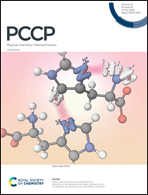Structural assignments of yttrium oxide cluster cations studied by ion mobility mass spectrometry†
Abstract
The geometric structures of yttrium oxide cluster ions, YnOm+ (n = 3–11), were experimentally assigned for stable compositions by ion mobility mass spectrometry combined with theoretical calculations. The stable compositions were firstly determined by collision induced dissociation experiments in mass spectrometry as YO(Y2O3)x+ and YO2(Y2O3)x+ for odd numbers of Y atoms (n = 2x + 1) and (Y2O3)x+ and O(Y2O3)x+ for even numbers of Y atoms (n = 2x). The structures of the ions with the above compositions were assigned by comparing the collision cross sections obtained in the ion mobility measurement with those obtained by theoretical calculations. The assigned structures have the following two characteristic features. Firstly, metal–metal or oxygen–oxygen bonds were rarely observed, and most of the oxygen atoms bridge two Y atoms, which is due to the ionic bonding nature between Y3+ and O2− ions. Secondly, common Y-atom frameworks were obtained for the ions with the same number of Y atoms n. For example, for the clusters with even numbers of Y atoms, one atomic oxygen radical anion (O−) in the most stable structures of (Y2O3)x+ was replaced with a superoxide ion (O2−) to form the most stable structures of O(Y2O3)x+ ions, keeping the Y-atom framework geometries.



 Please wait while we load your content...
Please wait while we load your content...